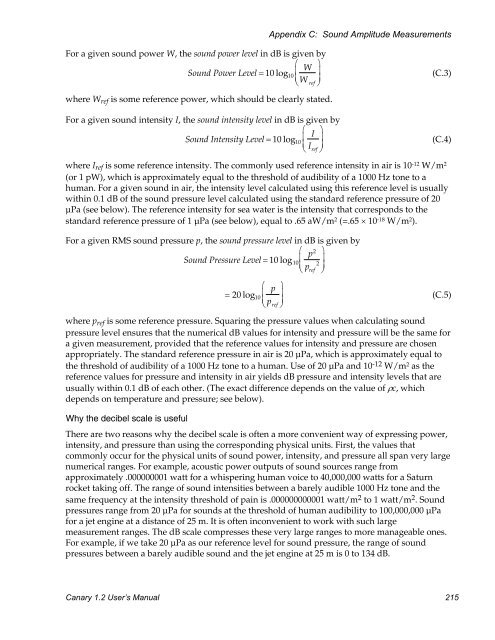User's Manual - Cornell Lab of Ornithology - Cornell University
User's Manual - Cornell Lab of Ornithology - Cornell University
User's Manual - Cornell Lab of Ornithology - Cornell University
You also want an ePaper? Increase the reach of your titles
YUMPU automatically turns print PDFs into web optimized ePapers that Google loves.
Appendix C: Sound Amplitude MeasurementsFor a given sound power W, the sound power level in dB is given by⎛W⎞Sound Power Level = 10 log 10⎜⎝ W ref⎟⎠where W ref is some reference power, which should be clearly stated.For a given sound intensity I, the sound intensity level in dB is given by⎛I⎞Sound Intensity Level = 10 log 10⎜⎝ I ref⎟⎠(C.3)(C.4)where I ref is some reference intensity. The commonly used reference intensity in air is 10 -12 W/m 2(or 1 pW), which is approximately equal to the threshold <strong>of</strong> audibility <strong>of</strong> a 1000 Hz tone to ahuman. For a given sound in air, the intensity level calculated using this reference level is usuallywithin 0.1 dB <strong>of</strong> the sound pressure level calculated using the standard reference pressure <strong>of</strong> 20µPa (see below). The reference intensity for sea water is the intensity that corresponds to thestandard reference pressure <strong>of</strong> 1 µPa (see below), equal to .65 aW/m 2 (=.65 × 10 -18 W/m 2 ).For a given RMS sound pressure p, the sound pressure level in dB is given by⎛ p 2 ⎞Sound Pressure Level = 10 log 10 ⎜2⎝ p ref⎟⎠⎛ p ⎞= 20 log 10 ⎜⎝ p ref⎟⎠where p ref is some reference pressure. Squaring the pressure values when calculating soundpressure level ensures that the numerical dB values for intensity and pressure will be the same fora given measurement, provided that the reference values for intensity and pressure are chosenappropriately. The standard reference pressure in air is 20 µPa, which is approximately equal tothe threshold <strong>of</strong> audibility <strong>of</strong> a 1000 Hz tone to a human. Use <strong>of</strong> 20 µPa and 10 -12 W/m 2 as thereference values for pressure and intensity in air yields dB pressure and intensity levels that areusually within 0.1 dB <strong>of</strong> each other. (The exact difference depends on the value <strong>of</strong> ρc, whichdepends on temperature and pressure; see below).Why the decibel scale is usefulThere are two reasons why the decibel scale is <strong>of</strong>ten a more convenient way <strong>of</strong> expressing power,intensity, and pressure than using the corresponding physical units. First, the values thatcommonly occur for the physical units <strong>of</strong> sound power, intensity, and pressure all span very largenumerical ranges. For example, acoustic power outputs <strong>of</strong> sound sources range fromapproximately .000000001 watt for a whispering human voice to 40,000,000 watts for a Saturnrocket taking <strong>of</strong>f. The range <strong>of</strong> sound intensities between a barely audible 1000 Hz tone and thesame frequency at the intensity threshold <strong>of</strong> pain is .000000000001 watt/m 2 to 1 watt/m 2 . Soundpressures range from 20 µPa for sounds at the threshold <strong>of</strong> human audibility to 100,000,000 µPafor a jet engine at a distance <strong>of</strong> 25 m. It is <strong>of</strong>ten inconvenient to work with such largemeasurement ranges. The dB scale compresses these very large ranges to more manageable ones.For example, if we take 20 µPa as our reference level for sound pressure, the range <strong>of</strong> soundpressures between a barely audible sound and the jet engine at 25 m is 0 to 134 dB.(C.5)Canary 1.2 User’s <strong>Manual</strong> 215
















